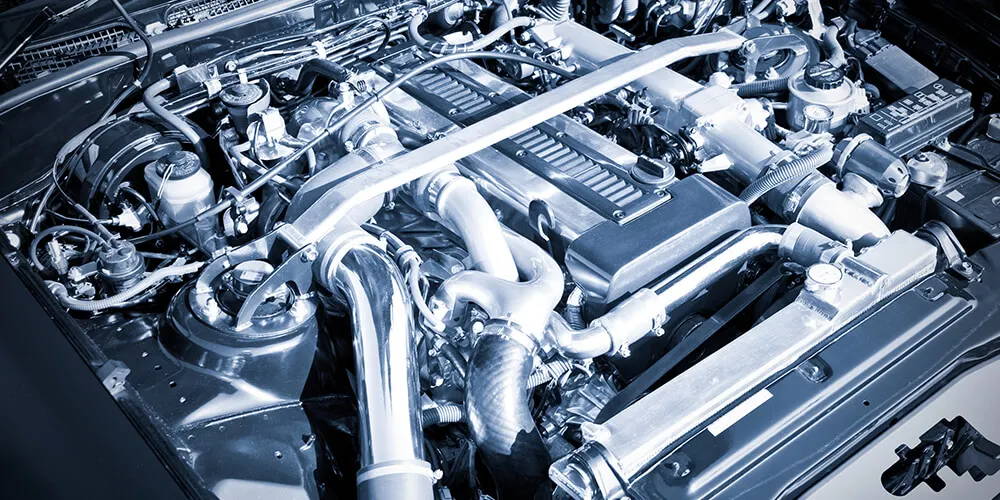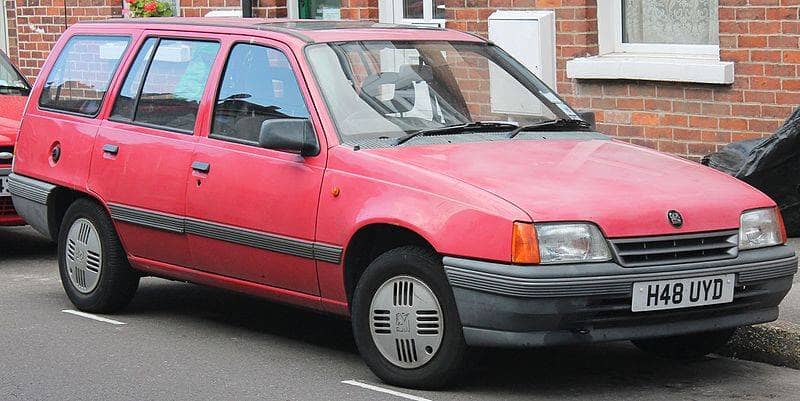The engine bay is probably one of the most overlooked parts of a car when it comes to detailing!
You only see it every few miles… that is, if you're changing your car's oil yourself. Even though the engine bay can be overlooked, there are many key benefits to performing a full detail on it a few times a year.
Today, we’ll take you through a step-by-step guide on how to detail your engine bay like a pro and explain why it's so important to keep clean!
If you're detailing an engine bay, Decon Soap is what you want. Period. This decontamination car wash soap eats away heavy grime like nothing. Our most heavy duty soap yet.
"You can actually feel how clean it gets the car surface. It squeaks as you wash it and gets super smooth. I do not know what is in this stuff but it is highly effective."
- Daniel M. from Washington. 5-star review.
Here's Why You Should Clean Your Engine Bay
Maintaining your engine is very important, since you want to make sure you're changing the oil as recommended by the manufacturer, but that you also detail it a few times a year to protect the paint, rubber, and plastic pieces from fading or even worse, cracking over time.
All the rubber and plastic pieces take a real beating over the years because of the extreme heat in the engine bay and general wear and tear. By performing an engine bay detail, you can prevent costly repairs down the line, as well as give yourself a chance to inspect your engine's condition between maintenance cycles.
But let’s be real. If you’re reading this article, it means you have a real pride of ownership. You know you can get by with a dirty engine bay. You’ll still get from point A to point B just fine. Your re-sell value won’t even be all that much affected unless you have a classic. But you care. You want a clean, beautiful engine when you open up that hood.
Common Mistakes To Avoid:
Mistake #1: Detailing a Hot Engine Bay
Make sure to avoid detailing a hot engine bay. The heat will cause your chemicals and water to dry on the surface, making you use a lot more product and also causing damage to sensitive pieces in the engine bay itself. Also, keep in mind that super cold water coming into contact with hot metal pieces can cause the metal to warp, so avoid a hot engine bay!
Mistake #2: Not Using Safety Equipment
Because engine bays have a lot more dirt, grease, grime, and very tight areas, you will need to use stronger chemicals like degreasers while getting your hands into some pretty dirty and tight areas. Therefore, it's very important to glove up and wear safety goggles prior to getting started.
Mistake #3: Using Not-Up-to-Par Aftermarket Parts
Most factory parts in modern vehicles are waterproof or water-resistant, but the water resistance from aftermarket parts differs from manufacturer to manufacture. So, if a vehicle has any aftermarket parts, make sure to take extra precaution with those areas!
Phase 1) Planning
Equipment And Products You’ll Need:
Products:
- Torque Detail High-Quality Microfiber towels
- Torque Detail Mirror Shine
- Torque Detail Plastic Restore
- Torque Detail Decon Soap
- Degreaser / All Purpose Cleaner (We recommend Simple Green, it’s eco-friendly, a safe product to use, and works well.)
Tools:
- Vacuum, leaf blower, or air hose to blow off surface dirt (optional)
- A variety of detailing brushes
Safety Equipment:
- Rubber gloves
- Safety glasses
- Dust mask
- Soapy water (Torque Detail Decon Soap + water in a spray bottle. Can use dish soap instead but it doesn’t have as strong decontamination properties.)
Optional, but useful:
- Paint markers (Useful for restoring the look of rusty bolts and touching up small, unpainted areas.)
- Plastic garbage bags
- Garden hose with sprinkler nozzle
What Type of Weather Is Best To Super Clean Your Engine Bay In?
Just like washing your car, it's preferable to detail your engine bay on a warm day with some slight overcast if possible.
Just like working with a super hot engine bay, working in the extreme sun will cause chemicals to dry and damage areas in your engine bay. If you have no other option but to work in the sun, make sure to clean and detail the engine bay section by section to avoid chemicals drying on the surface.
The No-No List! What Car Parts You SHOULDN’T Get Wet
Every car's engine bay is different, but generally, there are a few areas you want to avoid getting wet with excessive chemical cleaners or water. Things like…
...Battery terminals
...The alternator
...Spark plugs
...Exposed fuses,
Those are a good idea of what areas you need to be mindful of while detailing the engine bay. We recommend that you look over your engine bay to find these red flag areas and make sure to keep them in mind throughout the detailing process. If you’re working on sports cars or supercars, you might even run into some very expensive parts and materials such as carbon fiber trim pieces, which cost thousands of dollars to replace. These are also areas you want to take note of to avoid causing any kind of damage.
Should You Use A Pressure Washer?
We see a lot of videos recommending high-powered pressure washers for engine bay details. Pressure washers are excessive for engine bay details and can also cause mechanical damage because of the high pressure output. Instead, we recommend using a garden hose with a sprinkler attachment. Let the chemicals and brushes do the cleaning, not excessive amounts of water and pressure!
It’s just not worth the danger.
Phase 2) The Dry Clean
Dry cleaning will allow you to remove surface dust and grime from the engine bay. Using a vacuum with a detailing brush, remove all the surface dust, leaves, and dirt from the engine bay by brushing it into the vacuum nozzle. The detail brush will help you get into smaller nooks and crannies that your vacuum nozzle can’t access. This will help you loosen the dirt and grime, allowing you to push it into the vacuum. Continue this process throughout the whole engine bay, making sure to remove as much loose contamination as possible. You could also use a leaf blower to blow away loose debris and dust. This is super easy, but make sure to wear a dust mask and safety goggles for personal protection!
Phase 3) The Basic Wash
Safety Tip: Disconnect The Battery And Remove It Completely From The Car
Prior to applying any chemical solutions or water to the engine bay, make sure to remove the positive and negative terminals from the battery. This will stop any electricity running through the engine bay and prevent anything from shorting out. For maximum safety for you and your car, we also recommend removing the battery from the vehicle entirely. Some car batteries are located in the trunk, so make sure to go to the rear of the vehicle and disconnect the battery there if this is the case.
Cover Any Sensitive Areas With Plastic Bags (Garbage Bags) Or Other Waterproof Cover
Cover any sensitive areas we mentioned earlier in phase 1 with a plastic bag. Use a few rubber bands around the plastic bags to make a watertight seal and prevent the bags from getting loose or moving around. For smaller tight areas, aluminum foil is also a great option. Just take an adequate amount of aluminum foil and shape it to the sensitive area. This step will prevent excessive amounts of water from getting on or in sensitive parts.
Get The Garden Hose Out And Wash That Dirty Bay!
Using your garden hose, perform a pre-rinse of the engine bay, starting from the bottom of the hood and working your way down. This pre-rinse stage will wash away any leftover loose dirt, but also provide lubrication for your detailing brushes in the next few phases.
Phase 4) The Degreasing: Removing Grease, Oil, Grime, And Stubborn Mud
Spray your choice of degreaser or all-purpose cleaner on all the extremely dirty parts of the engine bay first, then continue spraying it onto the rest of the engine bay. Let the product sit for a few moments - this will let the degreaser break down the dirt and grime, meaning less elbow grease! For the really dirty areas, spray some ore degreaser onto your detailing brush and the agitate surface, making sure to get in all the nooks and crannies. Then, use your garden hose to spray off the degreaser, along with all the dirt and grime it loosened from the surface.
Phase 5) Soap Time
Using Torque Detail Decon Soap mixed with water in a spray bottle, spray down the whole engine bay, then use a detailing brush to loosen all the leftover dirt and grime from the previous steps. This step will also ensure you remove and neutralize any leftover degreaser from the engine bay. After spraying down and brushing the whole engine bay including the hood shroud, use your garden hose to perform a final rinse.
Phase 6) Detailing: Finishing Off The Perfect Clean Engine Bay
Now that the engine bay is perfectly clean, it's time to start detailing and adding protection to the plastic, rubber, and paint surfaces!
Starting with your plastics and rubbers, we recommend using a plastic and rubber conditioner./ This will add a nice rich, dark look to all your plastics but also condition them to prevent cracking and fading. Take your favorite plastic and rubber conditioner and apply a substantial amount on a microfiber towel or foam applicator pad, then evenly apply it throughout the engine bay.
Mirror Shine Wax & Sealant Spray
Get a Showroom Shine in Minutes!
Just spray on and buff with a simple microfiber towel. Designed to be hydrophobic and repel water, dirt and other elements from coat. Car maintenance has never been easier.
After conditioning your plastics and rubber, grab a quality spray paint sealant or wax and apply it to all the painted and metal surfaces in the engine bay. This will add a lot of gloss and shine while adding great protection.
Tips For Different Scenarios
Now, let's go over a few different scenarios you might run into while detailing your engine bay.
Dealing With Hard-To-Reach Places
Useful brush to get into hard spots, found on Walmart for around 10 bucks.
Using a wheel woolie or a thin soft bristle pipe cleaning brush in hard-to-reach places is a great idea! This will allow you to clean the areas without getting your hands super dirty in tight areas of the engine bay. If you need to get a microfiber towel someplace tight, just flip your cleaning brush around and wrap the towel around the handle of the brush. Now you can push the towel into areas where your hands couldn't fit.
Be Mindful Of Puddled Water
Make sure to use a vacuum or leaf blower to suck up or blow out any excess water. If the water sits and puddles in certain areas of the engine bay, it can attract dirt and grime but also possibly damage certain parts of the engine bay.
Cleaning Corroded Metal Parts In The Engine Bay
Use a wire metal brush to clean off any rust that has developed over time on things such as metal clips and bolts. After that using a silver or black paint marker, color them in to make them look almost brand new!
Tips For Restoring Plastic
As we mentioned earlier, plastics and rubber can fade over time. If your engine bay plastics look faded, use a few layers of plastic and rubber conditioner on the affected areas, leaving a few minutes between coats. This should be able to restore your faded plastics, but if they still look faded, you might have to use a plastic dye or paint to restore the area. This can be a bit messy, but the results are worth it!
Tips For Painting Parts
Over the years, painted plastic lettering on areas such as engine or coolant caps can fade. Taking a paint marker, carefully repaint the words. This might be a small detail, but it makes a world of difference! If you need to spray paint a certain component of the engine, try removing it from the vehicle prior to spray painting in order to prevent overspray. If you can't remove the part from the vehicle, make sure to cover the rest of the engine bay and all painted and glass areas of the vehicle with newspaper and masking tape. You don't want to risk getting overspray on areas that don't need paint, so be sure to prepare the vehicle properly before spray painting.
Electrical Component Safety
We cannot stress this enough: make sure you familiarize yourself with sensitive electrical components within the engine bay and disconnect the battery prior to starting the engine bay detail. This will be the safest process for both you and your vehicle, and will allow you to get the best possible results without damaging anything. Make sure to also let the vehicle sit for a few hours prior to reconnecting the battery and starting the motor. This will allow any excess water that has been missed during the detailing process to evaporate from the engine bay.
Extra Detailer Pro Tips
How Can I Clean My Engine Bay Without Water?
Free-flowing water is a great resource, but you might find yourself in a situation where you don't have access to a hose. In this case, you can always utilize Torque Detail Turbo Waterless Detailer to lightly clean up and condition your engine bay. It won't provide you the same exact results as a full engine bay detail with flowing water, but it's something to remove the majority of the dirt and grime that's accumulated while simultaneously conditioning your plastics, rubber, and painted pieces.
Tips for Battling Salt Corrosion In The Engine Bay
If you're in an area that's affected by a lot of salt corrosion, you might want to look into getting your engine bay ceramic-coated. There are ceramic coatings designed for every surface of your vehicle, and your engine bay is no different. Ceramic coatings are very durable, long-lasting, and offer a much thicker layer of protection compared to waxes and sealants. This will prevent salt and grime from sticking to metal pieces and causing future corrosion, leaving your engine bay looking newer for longer!
If you're detailing an engine bay, Decon Soap is what you want. Period. This decontamination car wash soap eats away heavy grime like nothing. Our most heavy duty soap yet.
"You can actually feel how clean it gets the car surface. It squeaks as you wash it and gets super smooth. I do not know what is in this stuff but it is highly effective."
- Daniel M. from Washington. 5-star review.
Summary: Are You Enjoying Your Showroom Shine?
Now that you have your engine bay detailed, you can show it off your neighbors or your local car meet! Having a clean and well-detailed engine bay is something to take pride in because it shows how much you care for your vehicle. It also makes it easier on your mechanic when performing your next oil change.







